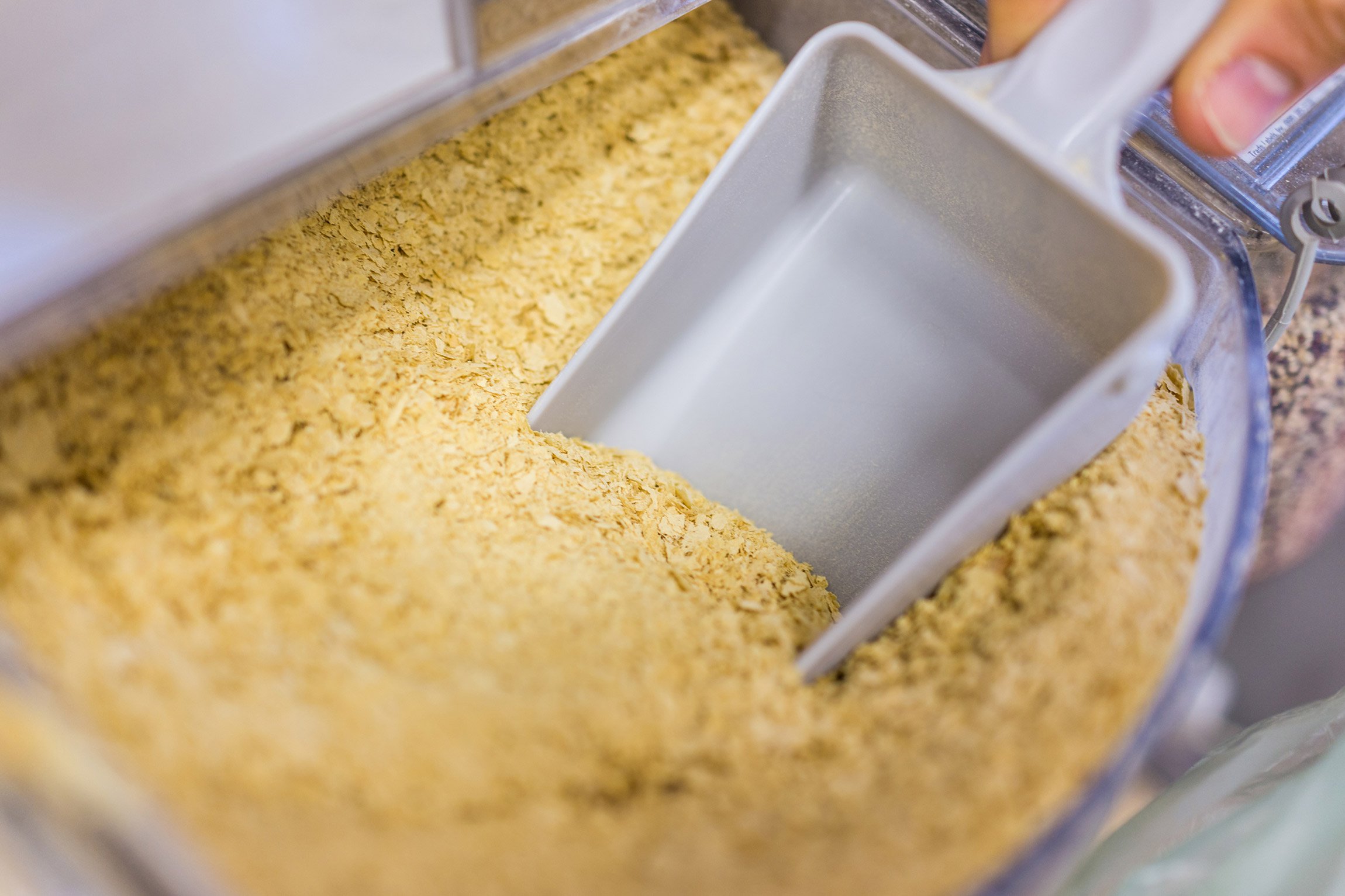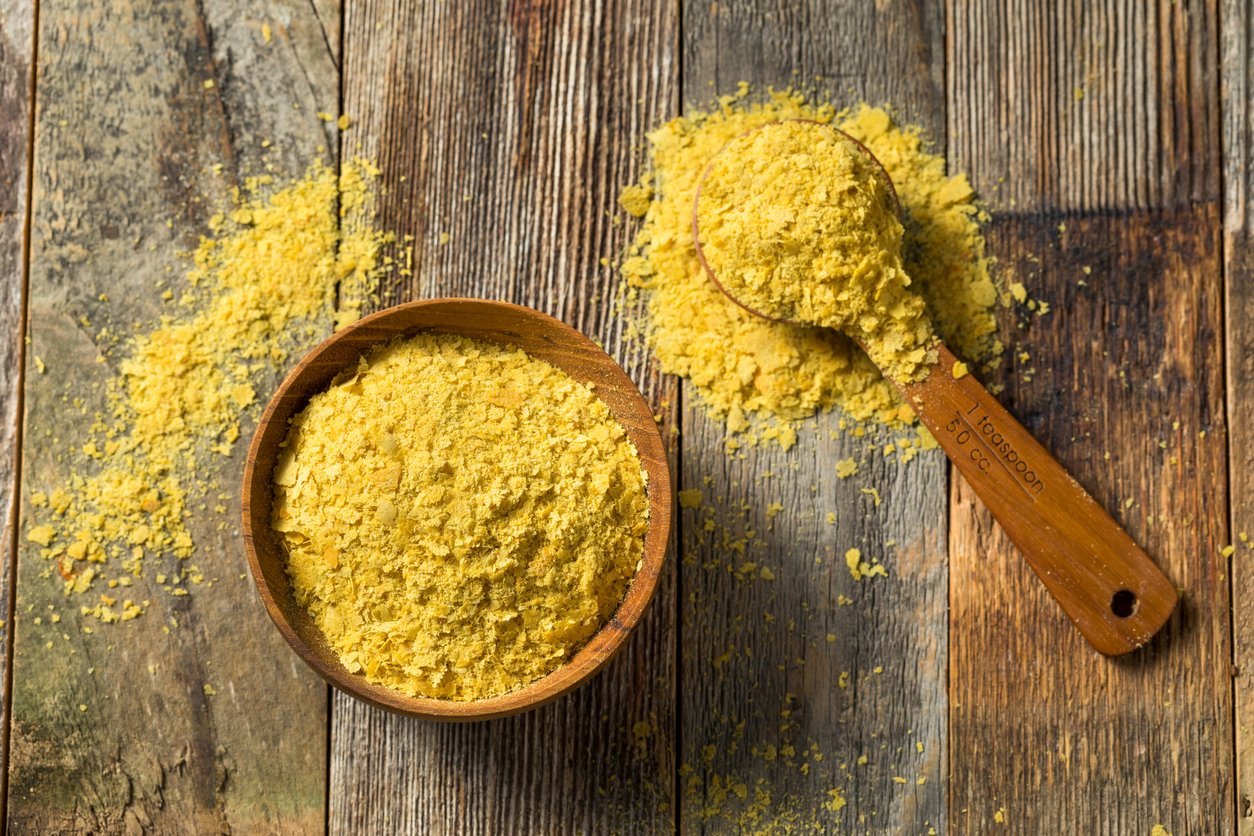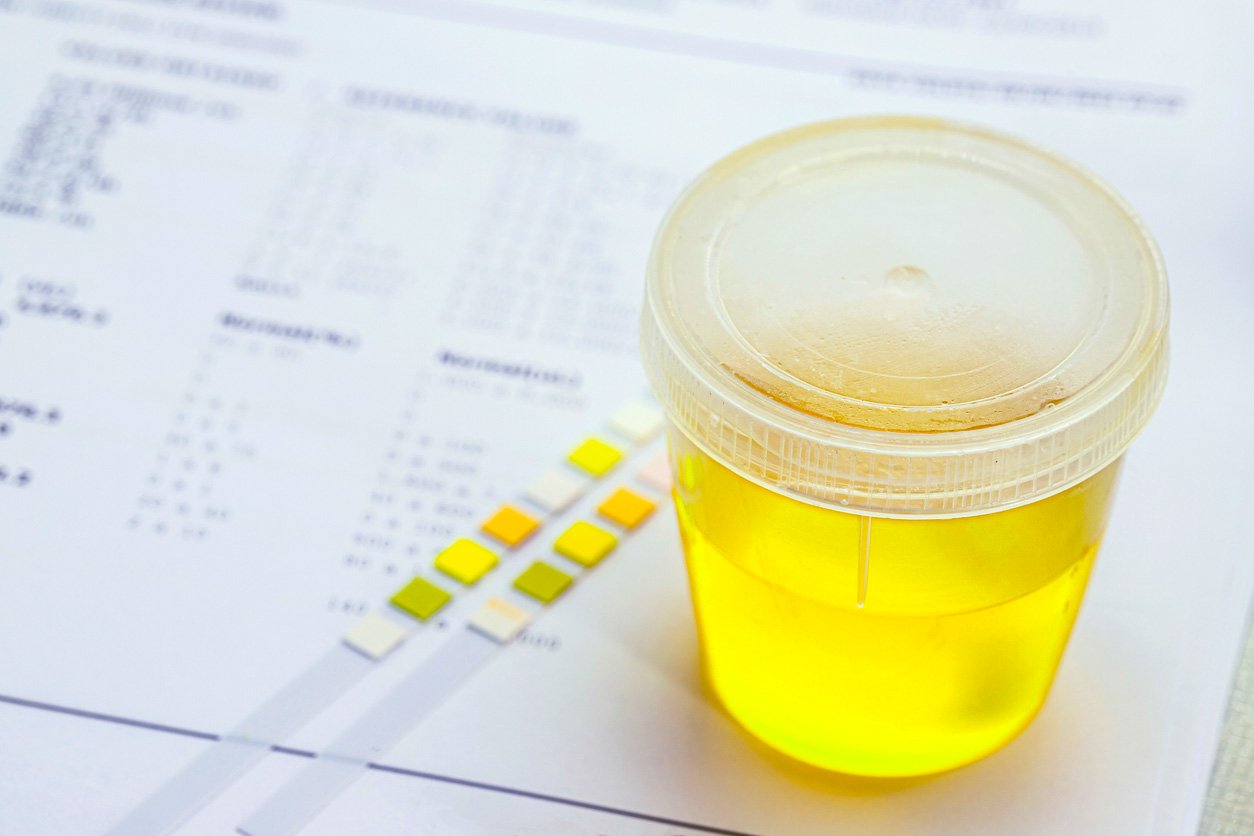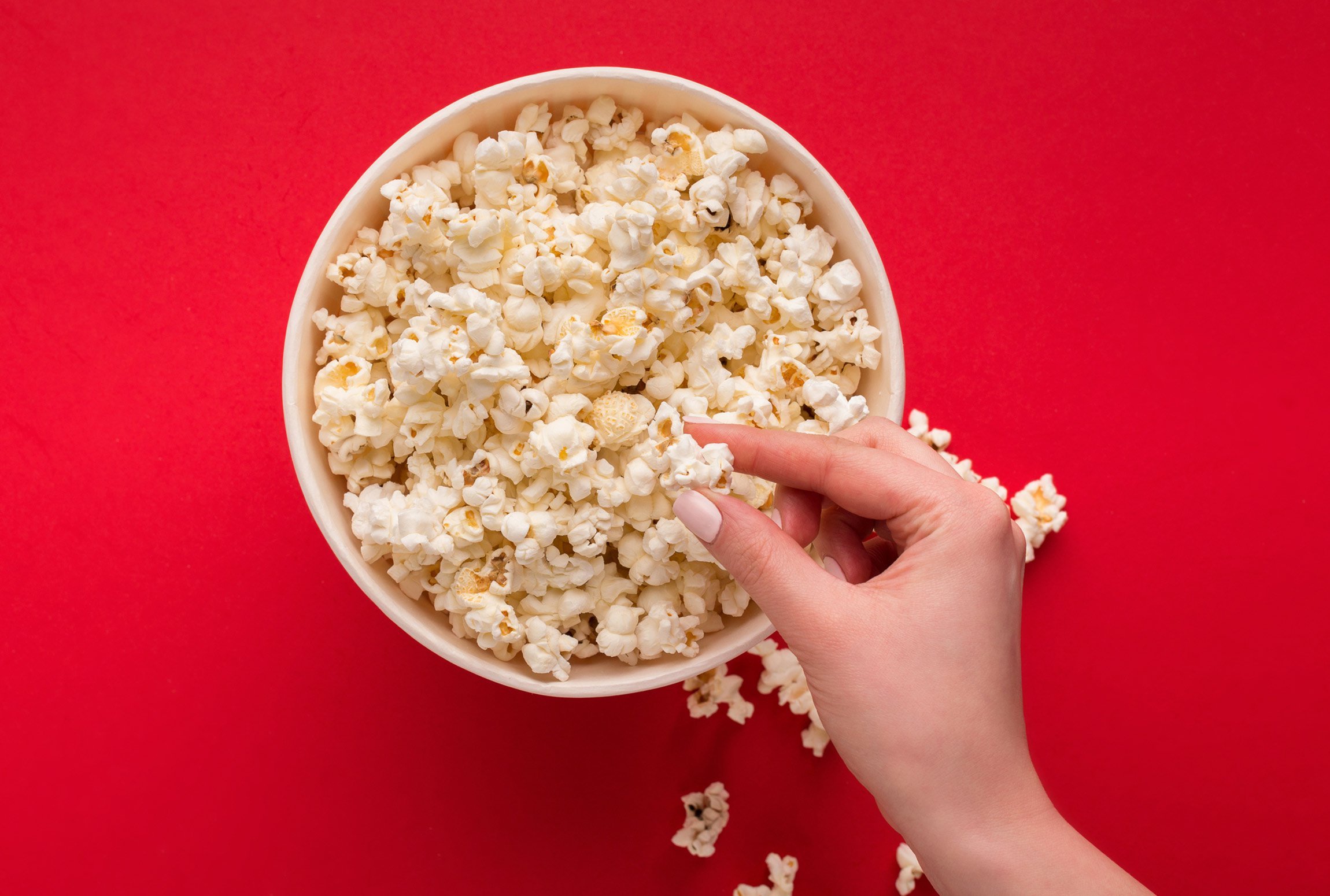If an Oscar existed for terrible brand marketing, the person who came up with the name “nutritional yeast” would get one.
Yet, you’ll probably find a vat of nutritional yeast — also known as dietary yeast — in the fridge or pantry of most plant-based eaters. I even know people who carry a jar or shaker of nutritional yeast (which many devout users affectionately refer to as “nooch”) in their purse or car in case they encounter a bland meal.
Nutritional yeast is even showing up on the menus of restaurants lately. You can find it as an ingredient in salad dressings and croutons. And it’s even being used as a seasoning in omnivorous NYT Cooking recipes.
So, what is nutritional yeast? Where does nutritional yeast come from? Is it good for you? Why are some people fanatical about nooch? And are there any nutritional yeast dangers to know about?
Wonder no more. Here’s a deep dive to bring you everything you ever wanted to know about nutritional yeast.
What Is Nutritional Yeast?

Nutritional yeast is a condiment or seasoning used to make bland dishes flavorful and delicious — and to add a burst of umami to almost anything. It also adds an appealing, yellow-orange color to recipes.
What does nutritional yeast taste like, you might ask? The flavor of nutritional yeast is somewhat savory, cheesy, or nutty.
Nutritional yeast can be either fortified (with added vitamins and minerals) or unfortified. The former version is often used as a source of important vitamins and minerals, especially for plant-based eaters.
Plus, nutritional yeast doesn’t contain animal-derived ingredients. This makes nooch a useful culinary alternative to dairy cheese in certain dishes.
Where Does Nutritional Yeast Come From?
Nutritional yeast comes from the same species of yeast (Saccharomyces cerevisiae) used to make beer, bread, or kombucha. But it’s a different end product.
One major difference is that, for the most part, people use baker’s and brewer’s yeast in their active form. Nutritional yeast is inactive, so it has no leavening ability. In other words, it won’t make dough rise — and it won’t reproduce inside you, even if you eat it raw.
Nutritional yeast is made by growing S. cerevisiae on a sugar-rich molasses medium — usually sugar cane or sugar beets. Then, it is deactivated with heat, washed, pasteurized, dried, and crumbled.
In the lingo of yeast professionals, nutritional yeast is a primary-grown yeast, which means it’s cultivated specifically for its nutritional value and not as a by-product or a means to another recipe.
Which leads us to our next section.
Nutritional Yeast Nutrition Facts
Not only does nutritional yeast taste good, but it can also be good for you!
Nooch has an unassuming appearance in the form of small flaky pieces or fine powder. Yet, it’s packed with several nutrients that are in short supply in the modern Western diet.
Mini-disclaimer: Though exact nutrients and their amounts can vary between brands, many nutritional yeasts have a similar nutritional makeup, especially fortified versions. Here’s a cheat sheet of the nutrition facts of some of the most popular nutritional yeast brands from the Vegetarian Resource Group.
B Vitamins in Nutritional Yeast
Fortified nutritional yeast is a powerhouse when it comes to B vitamins.
One tablespoon of nutritional yeast may contain 30–180% of the Reference Daily Intake (RDI) for various B vitamins. Some of these, including B1, B3, B5, B6, and B7, form naturally as yeast grows, and others — most notably vitamin B12 — are found in nutritional yeast through fortification.
B vitamins are involved in important bodily processes, such as metabolism, energy production, DNA synthesis, brain function, hormone regulation, and making blood cells.
Vegans and other people who eat a plant-based diet might look to nutritional yeast as a source of vitamin B12. Though fortified nutritional yeast will contain B12, it’s usually not enough to rely upon for all of your needs, so other sources are still important. For more about how to get the B12 you need, check out our article all about B12.
Protein in Nutritional Yeast
Nutritional yeast is over 50% protein by weight. In fact, it contains more protein per calorie than any meat product out there! In only ¼ of a cup of nutritional yeast, you’ll find 8 grams of protein, 3 grams of fiber, very little sodium, and no sugar.
Nutritional yeast is particularly rich in the essential amino acids lysine and tryptophan. Lysine helps the body absorb calcium, enhances the production of collagen, and may even prevent cold sores. Tryptophan is the precursor to two neurotransmitter hormones important for sleep: serotonin and melatonin.
What Minerals Are in Nutritional Yeast?
Nutritional yeast also contains a wealth of trace minerals, such as zinc, selenium, magnesium, phosphorus, and potassium. These are all essential nutrients for good health. They also support a strong immune system and active metabolism.
The potassium in nutritional yeast is particularly beneficial because most people in the modern world are getting too little potassium but too much sodium. This balancing of electrolytes is necessary to help regulate critical bodily functions.
Nutritional Yeast Antioxidants
Nutritional yeast contains potent antioxidants too, which help prevent cell damage that can lead to many chronic diseases.
One of the particularly potent antioxidants in nutritional yeast is glutathione, which plays an important role in cellular defense mechanisms — it can help protect your cells and eliminate toxins from your body. Nutritional yeast contains around 2.5 mg of glutathione per gram — a very concentrated amount.
Nutritional Yeast Health Benefits

These tasty little yellow flakes are much more than an easy way to sprinkle vitamins and minerals into your diet. Nutritional yeast has a wide range of health benefits backed by positive results from scientific research studies.
Nutritional Yeast and Cholesterol
The beta-glucans in nutritional yeast may help lower blood cholesterol and triglyceride levels (which is good news for your heart!).
This effect has been researched primarily in oats (another rich source of beta-glucans), but yeast has similar benefits.
The impact of yeast on cholesterol has been of scientific interest for a long time. In a small 1999 study published in the American Journal of Clinical Nutrition, 15 obese men with high blood cholesterol levels consumed 15 grams of yeast-derived beta-glucans every day for eight weeks. They experienced an 8% reduction in their LDL (bad) cholesterol levels by the end of the study.
Also, in a 2015 study using a capsule of the yeast that nutritional yeast comes from, remnant lipoprotein particles in participants decreased by 15.5% over an eight-week period. These particles are triglyceride-rich precursors to LDL cholesterol and have been associated with the development of atherosclerosis and coronary artery disease.
Immune Effects of Nutritional Yeast
Studies show that the immune function of elite athletes is typically impaired by strenuous exercise — making them more likely (in the short run) to get sick. Nutritional yeast to the rescue!
In one study, athletes who ate just ¾ teaspoon of nutritional yeast per day experienced improved immune function.
Another study focused on marathon runners. They consumed a spoonful of nutritional yeast daily, which reduced the post-race incidence of upper respiratory infections. It also increased the runners’ overall physical AND mental health.
(I’m definitely no elite athlete, but I know how worn out I can be after a hard workout. After doing this research, I’m going to be sprinkling on more nutritional yeast. And since I love the taste, it’s not like I’m going to have to force myself!)
Athletes aren’t the only ones who can benefit from nutritional yeast’s immune benefits. Research shows that beta-glucans derived from fungi and yeast have immune-modulating effects and can significantly reduce symptoms of the common cold in anyone.
Is Nutritional Yeast Good for Your Gut?
S. cerevisiae, the yeast strain found in nutritional yeast, also has benefits for your gut health. Research shows this type of yeast has probiotic activity in the body, helping treat and protect against gastrointestinal disease by reducing inflammation. Yeast, like other probiotic-rich fermented foods, is good for your digestion and helps keep you regular while preventing diarrheal illness.
One recent 2022 study even concluded that S. cerevisiae could serve as an alternative method for treating bacterial and fungal infections, especially in the presence of antibiotic resistance. Since antibiotics don’t discriminate against microbes and impact your entire microbiome, this is a welcome potential line of defense that can help shore up, not destroy, beneficial gut flora.
Are There Any Nutritional Yeast Dangers You Should Be Aware Of?

Nutritional yeast offers a lot of benefits to your health. But does it have any downsides? Here are a few things to be aware of.
B Vitamin Excess
Nutritional yeast naturally contains niacin, which can cause a reaction called niacin flush if consumed in excess. High doses of niacin may also interact with certain medications and potentially weaken their effects or worsen the symptoms of niacin flush. However, you’d have to use significantly more nutritional yeast than the recommended serving size for niacin to have these effects.
There is also a phenomenon that can occur from eating vitamin B2, or riboflavin, in excess: neon yellow urine. Bragg nutritional yeast provides 240% of the Daily Value (DV) for vitamin B2 in one tablespoon, and other brands are similar. B vitamins are water-soluble, meaning that when you eat them in large amounts, your kidneys will excrete whatever your body doesn’t need. This results in yellower-than-normal, vitamin B-rich urine. For some people, the color change can be pretty dramatic.
That’s right, not only do you have to make a mental note of when you eat beets (no, you’re not bleeding to death — you just ate beets last night!), you also may want to keep track of any substantial nooch consumption. That way, you won’t be alarmed the next day by a pee stream that practically glows in the dark.
GMO Nutritional Yeast
Some nutritional yeasts may be grown on beet molasses or other mediums that could be bioengineered.
About 90% of the sugar beets in the United States are the result of genetic engineering. Some nutritional yeast brands state that they are non-GMO, but unless they are USDA certified organic (or the equivalent in other countries), it is still possible that they have, in some cases, been grown on a substrate that had GMO origins.
Many nutritional yeast brands tell us that independent testing finds no presence of any GMO protein or DNA in the yeast. And some say that it isn’t found in the substrate, either.
I’m inclined to believe them. But it’s also possible that this is because the substrate is highly refined — and it could conceivably still have come from source materials, like sugar beets or corn sugar, which were genetically engineered.
I haven’t been able to get a direct answer about this from the manufacturers I’ve contacted, but this could be a point of concern for some. If you want to be 100% sure your nutritional yeast is GMO-free, you may want to go with a certified organic option. Both Starwest Botanicals and Bragg make fortified, organic nutritional yeast. If you want one that’s not fortified, Sari Foods, Foods Alive, and Dr. Joel Fuhrman all make non-GMO options that are free of added vitamins.
Why Some People Should Probably Avoid Nutritional Yeast
You will probably want to avoid nutritional yeast if you have a yeast allergy (for obvious reasons).
Similarly, if you have celiac disease or severe gluten intolerance, you might want to call the manufacturer of the brand of your choice to inquire about their testing processes. You can also look for a nutritional yeast brand that has been certified gluten-free through independent verification. Nutritional yeast is grown on a carbohydrate, and occasionally the medium contains grains. Therefore, cross-contamination with gluten can sometimes occur.
Additionally, individuals with Crohn’s disease should avoid nutritional yeast. The original study linking yeast to Crohn’s disease, published back in 1988, found that people with Crohn’s disease had increased antibodies to yeast. And after placing Crohn’s patients on a yeast-free diet, even reintroducing ¼ teaspoon caused a significant recurrence of symptoms.
In 1992, another study found that Crohn’s patients with elevated yeast antibodies had higher disease activity when given small yeast capsules. Since then, there have been many other studies with similar results. While it’s unclear what exactly the causation link is between yeast and Crohn’s disease, yeast reactivity is high in Crohn’s, so it’s wise to avoid all forms just to be safe.
Lastly, some nutritional yeast varieties come fortified with folic acid, which is the synthetic form of vitamin B9 (folate is the natural form). While B9 can be beneficial, folate and folic acid function very differently in the body. You may want to avoid nutritional yeast fortified with folic acid, especially if you have an MTHFR genetic mutation, which can cause impaired folic acid metabolism. Although people with the MTHFR mutation are at risk for folate deficiency, the best form to take would be 5-MTHF, not regular folic acid. (For more on the different forms of vitamin B9, and the difference between folic acid and folate, see this article.)
Nutritional Yeast Myths
You might also run across a couple of misconceptions about nutritional yeast if you surf too many evidence-deficient websites.
Nutritional Yeast and Candidiasis
One myth about nutritional yeast is that consuming too much of it will cause yeast overgrowth in your body. This actually can’t happen because nutritional yeast is inactivated, and it doesn’t contain Candida albicans. Further, the S. cerevisiae yeast has been proven to be a remedy in treating certain chronic infections and has never been shown to be pathogenic for humans. In fact, it’s the seventh most prescribed herbal medication in Germany.
Nutritional Yeast and MSG
Because of its natural umami flavor, nutritional yeast is sometimes thought to contain monosodium glutamate (MSG). All yeast-based products contain glutamic acid, a naturally occurring amino acid. However, MSG is made by chemically altering glutamic acid to create an isolated sodium salt for flavor enhancement and is a documented food additive. While glutamic acid (and its ionized form, glutamate) and MSG are similar, they don’t behave the same way in the body. And true MSG has to be added to foods because it’s created in a lab.
Although MSG is produced in a similar way as nutritional yeast, it’s made from a different strain of bacteria. And nutritional yeast does not contain MSG.
How to Find and Use Nutritional Yeast

Now that you know all about this unique ingredient, what do you do with it?
You can find nutritional yeast in a shaker container, a bag, or sometimes in the bulk section at natural grocery stores. Depending on where I shop, I’ve found it stocked with the health foods, in the baking aisle, in the supplements section, and even mixed in with the condiments.
To preserve its vitamins and minerals, store nutritional yeast in a cool, dry place, like your refrigerator. You can store it in its original packaging or an airtight container — glass jars and silicone bags work nicely. When stored properly, nutritional yeast can last for up to two years.
Nutritional yeast goes well with many hot and cold dishes. Many people use it in place of Parmesan cheese. I mix nutritional yeast into soups, stews, homemade bread doughs, and salad dressings, and even sprinkle it onto salad, pizza, and avocado toast.
It also works well in creamy, cashew-based cheese sauces and as a light seasoning for air-popped popcorn. Some die-hard fans even enjoy the savory flavor it adds to smoothies.
To explore the many ways to use nutritional yeast, check out our other article featuring seven nutritional yeast recipes.
Nutritional Yeast for the Win
I think of nutritional yeast as the hush-hush culinary secret of plant-based eaters.
Not only does it offer an abundance of vital nutrients, but it also supports immunity and can help protect us from diseases. And on top of all that, when used well, it adds some pretty fantastic flavor!
So keep a bottle in your car, purse, briefcase, or backpack, and become a nooch-evangelist to your friends. Once they’re hooked, they’ll understand how all those veggies you eat can be so delicious!
Tell us in the comments:
- Does this help you understand what nutritional yeast is? What questions do you still have?
- What do YOU think of nutritional yeast?
- If you eat it, what’s your favorite brand or way to use it?
Featured Image: iStock/olgamiltsova




